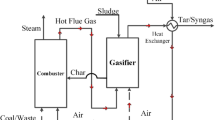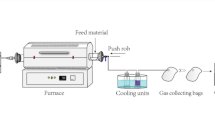Abstract
A CaO-based biochar (CSC) prepared from waste crab shell was used as a low-cost CO2 sorbent to enhance sludge steam gasification for H2-rich gas production. The effects of gasification temperature and CSC addition on sludge gasification performance were investigated. Results showed that the sludge steam gasification can be evidently enhanced with CSC addition and produced H2-rich gas with CO2 removal. The appropriate gasification temperature for CSC sorption-enhanced gasification should be below 800 ℃. With CSC addition at 700 ℃, H2 content increased to 63.2% (36.4% of pure sludge case) while CO2 content reduced to 3.5% (34.5% of pure sludge case). Meanwhile, the H2-rich syngas with high H2/CO ratio (up to 10.2) was achieved. At higher gasification temperature of 800 ℃ and 900 ℃, the CO2 absorbed in the CSC will be released via the decomposition reaction of CaCO3 and adding CSC showed slight effect on sludge gasification. Although the Ca content in CSC was less than 36%, CSC showed almost the same positive effects on H2 production and CO2 reduction compared to pure CaO in sludge gasification process. These findings indicated that CSC has the potential to replace CaO for sorption-enhanced gasification for sewage sludge disposal.











Similar content being viewed by others
References
Ahmadi-Pirlou M, Mesri Gundoshmian T (2021) The effect of substrate ratio and total solids on biogas production from anaerobic co-digestion of municipal solid waste and sewage sludge. J Mater Cycles Waste Manage 23(5):1938–1946
Wu L, Tu J, Cai Y, Wu Z, Li Z (2020) Biofuel production from pyrolysis of waste cooking oil fried sludge in a fixed bed. J Mater Cycles Waste Manage 22(4):1163–1175
Zhou J, Liu S, Zhou N, Fan L, Zhang Y, Peng P, Anderson E, Ding K, Wang Y, Liu Y (2018) Development and application of a continuous fast microwave pyrolysis system for sewage sludge utilization. Bioresource Technol 256:295–301
Kang S-W, Dong J-I, Kim J-M, Lee W-C, Hwang W-G (2011) Gasification and its emission characteristics for dried sewage sludge utilizing a fluidized bed gasifier. J Mater Cycles Waste Manage 13(3):180–185
Lee K-W, Lee WC, Lee HJ, Dong JI (2014) Gasification characteristics of sewage sludge combined with wood biomass. J Mater Cycles Waste Manage 16(4):642–649
Liu Y, Lin R, Man Y, Ren J (2019) Recent developments of hydrogen production from sewage sludge by biological and thermochemical process. Int J Hydrogen Energ 44(36):19676–19697
Zhang Z, Pang S (2017) Experimental investigation of biomass devolatilization in steam gasification in a dual fluidised bed gasifier. Fuel 188(15):628–635
Hu Q, Dai Y, Wang CH (2020) Steam co-gasification of horticultural waste and sewage sludge: Product distribution, synergistic analysis and optimization. Bioresource Technol 301:122780
Nipattummafeul N, Ahmed II, Kerdsuwan S, Gupta AK (2010) Hydrogen and syngas production from sewage sludge via steam gasification. Int J Hydrogen Energ 35(21):11738–11745
Chen S, Zhao Z, Soomro A, Ma S, Xiang W (2020) Hydrogen-rich syngas production via sorption-enhanced steam gasification of sewage sludge. Biomass Bioenerg 138:105607
Hong S-P, Dong J-I, Yeo S-K, Park I-H, Chung M-S, Kim D-I, Park Y-K (2011) Reduction of tar using cheap catalysts during sewage sludge gasification. J Mater Cycles Waste Manage 13(3):186–189
Gong M, Zhu W, Zhang HW, Ma Q, Fan YJ (2014) Influence of NaOH and Ni catalysts on hydrogen production from the supercritical water gasification of dewatered sewage sludge. Int J Hydrogen Energ 39(35):19947–19954
Liu H, Hu H, Luo G, Li A, Hong Y (2013) Enhancement of hydrogen production in steam gasification of sewage sludge by reusing the calcium in lime-conditioned sludge. Int J Hydrogen Energ 38(3):1332–1341
Chen S, Zhao S, Qi Z, Hu J, Xiang W (2017) Steam gasification of sewage sludge with CaO as CO2 sorbent for hydrogen-rich syngas production. Biomass Bioenerg 107:52–62
Yang X, Kan T, Kheradmand A, Xu H, Jiang Y (2020) Tunable syngas production from two-stage sorption-enhanced steam gasification of sewage sludge. Chem Eng J 404:126069
Liangyuan W, Haiping Y, Bin Li, Xintong W, Lei C (2014) Absorption-enhanced steam gasification of biomass for hydrogen production: effect of calcium oxide addition on steam gasification of pyrolytic volatiles. Int J Hydrogen Energ 39(28):15416–15423
Rios M, González A, Lora E, Olmo O (2018) Reduction of tar generated during biomass gasification: A review. Biomass Bioenerg 108:345–370
Ning Y, Xi C (2015) Sustainability: don’t waste seafood waste. Nature 524(7564):155
Bazargan A, Kostic M, Stamenkovic OS, Veljkovic VB, Mckay G (2015) A calcium oxide-based catalyst derived from palm kernel shell gasification residues for biodiesel production. Fuel 150(15):519–525
Zhou C, Stuermer T, Gunarathne R, Yang W, Blasiak W (2014) Effect of calcium oxide on high-temperature steam gasification of municipal solid waste. Fuel 122(15):36–46
Acknowledgements
The authors gratefully acknowledge the Supported by CAS Key Laboratory of Renewable Energy, Guangzhou Institute of Energy Conversion (No.E129kf0901) and Key Area Research and Development Program of Guangdong Province (No.2020B0202010004).
Author information
Authors and Affiliations
Corresponding author
Additional information
Publisher's Note
Springer Nature remains neutral with regard to jurisdictional claims in published maps and institutional affiliations.
Rights and permissions
Springer Nature or its licensor holds exclusive rights to this article under a publishing agreement with the author(s) or other rightsholder(s); author self-archiving of the accepted manuscript version of this article is solely governed by the terms of such publishing agreement and applicable law.
About this article
Cite this article
Li, Y., Wu, L., Xu, Q. et al. Hydrogen-rich gas production from sorption-enhanced sludge gasification using CaO-based biochar derived from crab shell as a CO2 sorbent. J Mater Cycles Waste Manag 24, 2353–2364 (2022). https://doi.org/10.1007/s10163-022-01480-z
Received:
Accepted:
Published:
Issue Date:
DOI: https://doi.org/10.1007/s10163-022-01480-z




